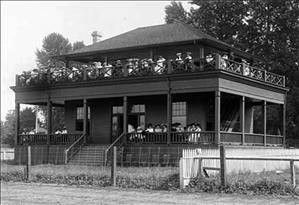In the first decade of the twentieth century, The Meadows Race Track, south of Georgetown along the Duwamish River, was the premier venue in the Northwest for horse racing. The one-mile, dirt track also saw the Northwest's first automobile race in 1905 and its first demonstration of the airplane in 1910.
In 1869, John Pinnell, a Seattle saloon and brothel owner, built the Seattle Race Course on land rented from pioneer Diana (Borst) Collins (1816-1876). (Diana and Luther Collins were members of the party of first white settlers to King County. They divorced in 1860 and Diana received her own half of their Donation Land Claim.) The track closed in 1878. In 1883, the track reopened as the Seattle Driving Park and remained active until 1892 when the land was developed for homes and businesses.
In 1902, The Meadows was built south of the Pinnell operation by the King County Fair Association under the leadership of Republican politician Aaron T. Van de Vanter (1859-1907). Van de Vanter had been mayor of Kent, King County Sheriff, and a state senator. The track was located between the south end of Beacon Hill and the Duwamish River. Grandstands seated 10,000 and the stables provided stalls for 1,000 horses (according to a 1928 article in The Seattle Times). Jockeys, trainers, and stable hands had their own quarters. An opulent clubhouse catered to the wealthy. Bookmakers paid $150 a day to the track for the privilege of taking bets out of 150 specially constructed stalls.
Racing began in 1902 with a 10-day season. Starting the following year, the racing seasons lasted 30 days each summer. When the weather was right, The Meadows was rated as one of the fastest tracks in the country. The proximity of the interurban rail line between Seattle and Tacoma made it convenient for race fans to go to the track. Special trains ran on race days with fans crowding into cattle cars. The Meadows flourished during the time before Georgetown was part of the city of Seattle. Saloons, brothels and gaming went largely unregulated.
Automobiles
On August 12, 1905, the Seattle Automobile Club organized the first automobile races in the Northwest. "Contrary to expectations no one was killed and on one injured. One machine caught fire and burned, and two others broke down" (Seattle Post-Intelligencer. Motorcycles competed for the first time as well.
Two years later, however, track founder Aaron Van de Vanter and another man died after an automobile in which they were riding to the track, for the last day of the 1907 horse-racing season, collided with a streetcar. Professional horse racing at The Meadows lasted only one more year. The 1908 season was the last, because the state legislature banned gambling on horse racing in 1909. Some amateur horse racing, along with more auto races and other events, continued at the track for some years.
Later, The Meadows barns held dairy cows and other livestock. During World War I the track was used as a depot for military supplies enroute to Russia. Van de Vanter's palatial home was transformed into a roadhouse, which received substantial attention from authorities during Prohibition.
Aeroplanes
The track was a good location for early airplane flights, which took the form of entertainment rather than science and engineering. Charles K. Hamilton (1885-1914) flew his Curtis biplane there on March 11, 12, and 14, 1910. Other aviators used the track to exhibit their skill, or lack thereof. Later, in 1912, a plane piloted by Phil Parmelee killed a boy and injured several persons.
In 1928, the area around The Meadows was selected for the site of Seattle's first airport, Boeing Field.

